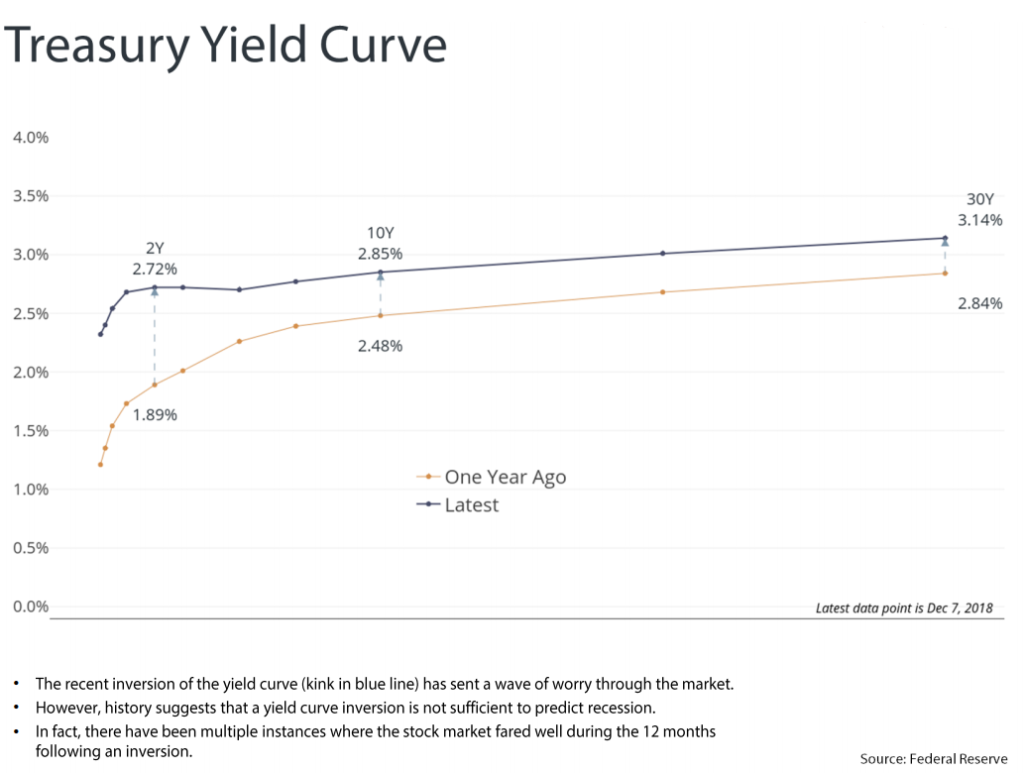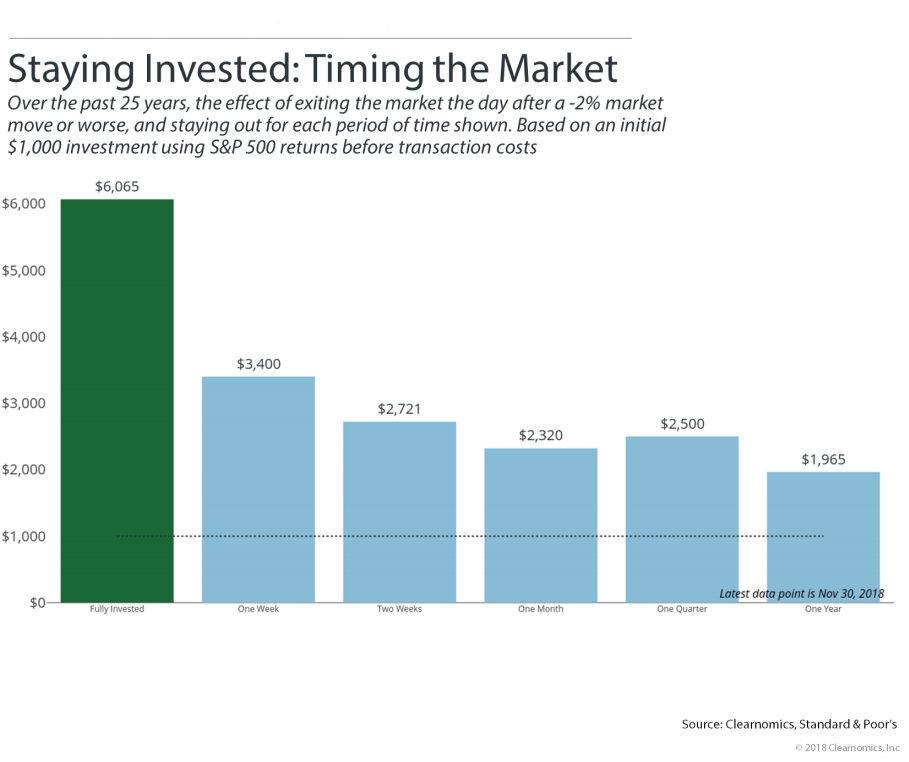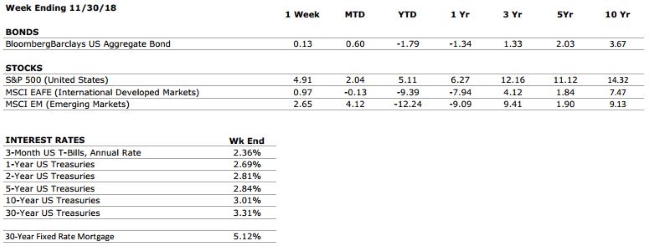“If anyone tells you that America’s best day are behind her, they’re looking the wrong way.” – President George H. W. Bush
Monthly Archives: December 2018
The Markets This Week
by Connor Darrell CFA, Assistant Vice President – Head of Investments
Stocks traded lower in a volatile week where the key focus of investors shifted from the U.S. trade conflict with China to the shape of the yield curve. Late in Monday’s trading session, the yields on five-year Treasury notes fell below two- and three-year Treasury yields for the first time in more than a decade. Historically, yield curve inversions have been a bearish signal for the economy, and markets sold off as a result. The focus of investors will likely now move to the Federal Reserve over the next week in anticipation of its final policy meeting of 2018. The Fed is widely expected to move forward with an additional rate increase, but some have begun to question whether the recent inversion of the curve will lead to a pause. Either way, investors should likely prepare for more volatility as the uncertainty permeates through global markets.
A Historical Look at Yield Curve Inversions
The recent inversion of the yield curve has sent a wave of worry through the market. However, it is important to note that while a curve inversion has typically preceded a recession, a curve inversion itself is not a sufficient condition for recession. According to Goldman Sachs Research, a historical analysis from the 1960s onward shows that in three of the last 10 instances when there has been an inversion in the yield curve, there was no recession over a subsequent two-year window. Furthermore, we have observed at least two instances since 1998 where the S&P 500 managed to achieve double digit gains over the 12 months immediately following an inversion of the three-year and five-year Treasury yields.
As the yield curve has flattened over the past several years (see chart below), the bond market has been signaling to investors that growth is likely peaking. Based on history, that fact alone does not mean that a recession is imminent, or even that the stock market has plateaued.  Additionally, when we also consider the level of central bank intervention in the global economy over the past several years (where global monetary policy involved direct manipulation of short-term interest rates), it is reasonable to question whether the signaling power of the yield curve has been impacted. In any case, investors should continue to watch other market and economic indicators in order to conduct a more complete assessment of the economic cycle. We still believe that when this more holistic approach is taken, it is difficult to draw the conclusion that a recession is near.
Additionally, when we also consider the level of central bank intervention in the global economy over the past several years (where global monetary policy involved direct manipulation of short-term interest rates), it is reasonable to question whether the signaling power of the yield curve has been impacted. In any case, investors should continue to watch other market and economic indicators in order to conduct a more complete assessment of the economic cycle. We still believe that when this more holistic approach is taken, it is difficult to draw the conclusion that a recession is near.
“Your Financial Choices”
The show airs on WDIY Wednesday evenings, from 6-7 p.m. The show is hosted by Valley National’s Laurie Siebert CPA, CFP®, AEP®. 
This week, Laurie welcomes back Attorney Dennis Pappas from the Law Offices of Vasiliadis Pappas Associates to discuss: Special Situations in Estate Planning. They will take your questions live on the air at 610-758-8810 or online through yourfinancialchoices.com.
 Recordings of past shows, including last week’s Year in Review & What’s Ahead with guests Timothy G. Roof, CFP® and Connor Darrell, CFA from Valley National Financial Advisors, are also available to listen or download at both yourfinancialchoices.com and wdiy.org.
Recordings of past shows, including last week’s Year in Review & What’s Ahead with guests Timothy G. Roof, CFP® and Connor Darrell, CFA from Valley National Financial Advisors, are also available to listen or download at both yourfinancialchoices.com and wdiy.org.
Valley National News
Last week, our team got to deliver special gifts to both the Volunteer Center of the Lehigh Valley and Second Harvest Food Bank of Lehigh Valley and Northeast Pennsylvania.
 On Thursday, Senior Vice President Laurie Siebert and CEO Matt Petrozelli dropped off a check to purchase 12,865 meals through Second Harvest thanks to our partnership with WDIY 88.1 FM. During their Fall Pledge Drive, for every $100 raised VNFA donated funds directly to Second Harvest to provide 21 meals for families in need.
On Thursday, Senior Vice President Laurie Siebert and CEO Matt Petrozelli dropped off a check to purchase 12,865 meals through Second Harvest thanks to our partnership with WDIY 88.1 FM. During their Fall Pledge Drive, for every $100 raised VNFA donated funds directly to Second Harvest to provide 21 meals for families in need.
 On Friday, a small group from our Bethlehem office delivered more than 40 Holiday Hope Chests to the Volunteer Center to be distributed to local children this holiday season through participating non-profits. The program provided 35 local organization with 7,500 wrapped and filled shoe boxes for underprivileged children.
On Friday, a small group from our Bethlehem office delivered more than 40 Holiday Hope Chests to the Volunteer Center to be distributed to local children this holiday season through participating non-profits. The program provided 35 local organization with 7,500 wrapped and filled shoe boxes for underprivileged children.
All of us at Valley National would like to extend our sincerest thanks to all of our clients and friends who helped us make these contributions by supporting our community initiatives. We look forward to continuing to make a difference with you in 2019!
The Numbers & “Heat Map”
Sources: Index Returns: Morningstar Workstation. Past performance is no guarantee of future results. Indices are unmanaged and cannot be invested into directly. Three, five and ten year returns are annualized excluding dividends. Interest Rates: Federal Reserve, Freddie Mac
US ECONOMIC HEAT MAP
The health of the US economy is a key driver of long-term returns in the stock market. Below, we grade 5 key economic conditions that we believe are of particular importance to investors.
|
CONSUMER SPENDING |
A+ |
Consumer confidence is near all time highs with recent tax reform providing further support. We are anticipating a strong holiday shopping season. |
|
FED POLICIES |
C- |
Despite recent comments from Fed Chairman Jerome Powell that rates are getting closer to “neutral”, we expect the Federal Reserve to raise interest rates one more time at its December meeting. Rising interest rates tend to reduce economic growth potential and can lead to repricing of income producing assets. |
|
BUSINESS PROFITABILITY |
B+ |
We have downgraded our Business Profitability grade to B+. Corporate earnings remain strong, but we anticipate earnings growth will taper off in 2019. We are also beginning to see a higher number of companies reducing forward earnings guidance, a sign that earnings growth may have reached its peak in 2018. |
|
EMPLOYMENT |
A+ |
The US economy added 255,000 new jobs in October, significantly more than the consensus forecast. For six months now, there have been more job openings available in the economy than there are unemployed workers to fill them. |
|
INFLATION |
B |
Inflation is often a sign of “tightening” in the economy, and can be a signal that growth is peaking. The inflation rate remains benign at this time, but we see the potential for an increase moving forward. This metric deserves our attention. |
|
OTHER CONCERNS |
||
|
INTERNATIONAL RISKS |
5 |
The above ratings assume no international crisis. On a scale of 1 to 10 with 10 being the highest level of crisis, we rate these international risks collectively as a 5. These risks deserve our ongoing attention. |
The “Heat Map” is a subjective analysis based upon metrics that VNFA’s investment committee believes are important to financial markets and the economy. The “Heat Map” is designed for informational purposes only and is not intended for use as a basis for investment decisions.
FROM THE PROS… VIDEO
 Estate Planning Series
Estate Planning Series
Senior Vice President Laurie Siebert reveals her five-step approach to estate planning. This 6-part series includes discussion about goals, asset inventory, heirs, taxes and execution of an estate plan. WATCH THE VIDEO SERIES
Did You Know…?
by Jaclyn Cornelius CFP®, EA, Vice President
In line with the giving season, many of us think about giving to our children, grandchildren, nieces and nephews and possibly even to our extended family or friends’529 plans as holiday gifts. A 529 Plan is a college savings plan that offers federal tax benefits such as five-year gift tax averaging and tax-free qualified distributions (as long as the plan satisfies a few basic requirements). Some states offer state income tax incentives as well. 529 plans may also be used to save and invest for K-12 tuition in addition to college costs. You can invest in any state 529 plan, not just your own state’s 529 plan and use the dollars invested to pay for college costs at any qualified college nationwide.
If you are a Pennsylvania resident, you can receive an income tax deduction for contributions made to any 529 Plan (limits apply). If you are a New York resident, you can receive a state income tax deduction if you contribute to a New York qualified 529 plan (limits apply). An independent company (Morningstar) recently released their analyst ratings for 2018 which provided reviews of over 60 of the largest 529 Plans. End of year is a good time to discuss the idea of reviewing your existing 529 Plans and giving levels (or discussing with your financial advisor if establishing one makes sense for your situation).
Quote of the Week
“Those who are happiest are those who do the most for others.” – Booker T. Washington
The Markets This Week
by Connor Darrell CFA, Assistant Vice President – Head of Investments
It was a strong bounce back week for equity markets, with the S&P 500 producing its largest weekly gain since December of 2011. Markets rallied strongly on Wednesday following comments made by Fed Chairman Jerome Powell in which he seemed to infer that the federal funds rate is much closer to the Fed’s target than was previously thought. Markets were also bolstered by strong online sales sentiment from the Black Friday shopping period and optimism that the G-20 summit would provide an opportunity for progress toward a trade deal with China.
On a far more somber note, both the NYSE and NASDAQ stock exchanges have announced that they will be closed on Wednesday December 5th to mourn the loss of President George H.W. Bush. Traditionally, the NYSE and NASDAQ stock markets have both closed for a day of national mourning following the death of a former president. The last such closure occurred on January 2, 2007, following the passing of former president Gerald Ford.
The Importance of Remaining Invested
After a smooth 2017 where S&P 500 returns were positive every single month of the year (the first time this has occurred since the index was formed), the U.S. equity market has experienced two separate corrections in 2018. Corrections are a normal market phenomenon but can be a very stressful time for investors. It is human nature to feel the need to “do something” during periods of market volatility, but the data suggests that the impacts can be significant.  The chart here shows the impact of exiting the market immediately following a -2% market move or worse, and the effect of remaining uninvested for a variety of time periods. The data is based upon the past 25 years of S&P 500 returns.
The chart here shows the impact of exiting the market immediately following a -2% market move or worse, and the effect of remaining uninvested for a variety of time periods. The data is based upon the past 25 years of S&P 500 returns.
When we attempt to time the markets to protect gains or avoid losses, it can be easy to forget that we technically have to get that timing decision correct two separate times (once to get out, and once to get back in again). The evidence suggesting that this is a risky endeavor is overwhelming, and it can cause us to miss out on opportunities to grow and compound our wealth. The S&P 500 returned almost 5% last week, further reiterating the importance of staying invested. Any investors who sold their equities during the November selloff would have missed out on last week’s rebound and would now face a difficult decision about when to get back in.
“Your Financial Choices”
The show airs on WDIY Wednesday evenings, from 6-7 p.m. The show is hosted by Valley National’s Laurie Siebert CPA, CFP®, AEP®. This week, Laurie welcomes back Tim Roof, CFP® and Connor Darrel, CFA from Valley National Financial Advisors to discuss the markets: The Year in Review and What’s Ahead
Laurie will take your questions live on the air at 610-758-8810 or online through yourfinancialchoices.com. Recordings of past shows are also available to listen or download at both yourfinancialchoices.com and wdiy.org.
VIDEO: Your Financial Choices November Recap
Spend a few minutes with Laurie Siebert to review her top takeaways from November and a preview of this month’s show topics lined up for Your Financial Choices radio on WDIY 88.1FM. WATCH NOW

